
Concept explainers
(a)
Interpretation:
Correct IUPAC name for the structure given has to be written.

Concept Introduction:
A common nomenclature of naming organic compounds has been developed by IUPAC. By usage of this nomenclature or rules, memorizing of names of organic compounds is not necessary.
IUPAC rules for naming
There are about five rules that has to be followed for naming an alkene and an alkyne. They are,
- The longest continuous carbon chain in the compound that contains double bond or triple has to be identified. This is known as parent compound.
- Suffix “–ane” (in name of
alkane ) is replaced with “-ene” for alkene or “-yne” for alkyne. - Numbering has to be done so that the lowest number is given to the double or triple bond.
- Naming and numbering has to be given for each atom or group that is attached to the parent chain. Numbering has to be done in a way that substituents get the least numbering.
- If the alkenes have more than one double bond they are called as alkadienes (two double bonds) or alkatrienes (three double bonds). Appropriate suffix has to be used depending on the number of multiple bonds present in the compound.
(a)
Explanation of Solution
Given compound and IUPAC name is.

IUPAC name given is wrong as the triple bond is not given the least numbering. Correct IUPAC name for the given structure can be given as shown below.
Longest carbon chain with triple bond is found to contain six carbon atoms. Therefore, the parent alkane is hexane. As a triple bond is present, the alkyne name is hexyne.
Numbering has to be given in a way that the triple bond gets the least numbering. In this case, triple bond is present between carbon-2 and carbon-3. Therefore, the parent alkyne is 2-hexyne.

The substituent present in the given structure are a methyl group on carbon-5. Number has to be added before the substituent names which indicate the carbon atom in which it is present. This gives the name of alkene as 5-methyl-2-hexyne.

Longest carbon chain containing triple bond is hexane. Position of triple bond is 2-hexyne. Substituent present in the chain is 5-methyl. Correct IUPAC name of the structure given is 5-methyl-2-hexyne.
(b)
Interpretation:
Correct IUPAC name for the structure given has to be written.
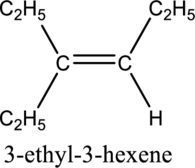
Concept Introduction:
Refer part (a).
(b)
Explanation of Solution
Given compound and IUPAC name is.
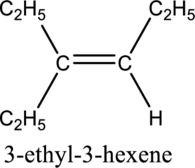
Longest carbon chain with double bond is found to contain six carbon atoms. Therefore, the parent alkane is hexane. As a double bond is present, the alkene name is hexene.
Numbering has to be given in a way that the triple bond gets the least numbering. In this case, triple bond is present between carbon-3 and carbon-4. Therefore, the parent alkyne is 3-hexene.
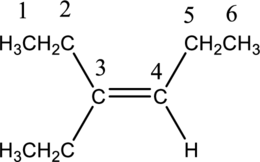
The substituent present in the given structure are an ethyl group on carbon-3. Number has to be added before the substituent names which indicate the carbon atom in which it is present. This gives the name of alkene as 3-ethyl-3-hexene.
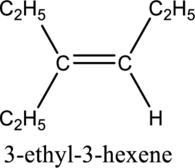
Longest carbon chain containing double bond is hexene. Position of double bond is 3-hexene. Substituent present in the chain is 3-ethyl. IUPAC name of the structure given is 3-methyl-3-hexene. Therefore, the given name is correct.
(c)
Interpretation:
Correct IUPAC name for the structure given has to be written.

Concept Introduction:
Refer part (a).
(c)
Explanation of Solution
Given compound and IUPAC name is.

IUPAC name given is wrong as the parent chain considered and the substituents are not given correctly. Correct IUPAC name for the given structure can be given as shown below.
Longest carbon chain with triple bond is found to contain nine carbon atoms. Therefore, the parent alkane is nonane. As a triple bond is present, the alkyne name is nonyne.
Numbering has to be given in a way that the triple bond gets the least numbering. In this case, triple bond is present between carbon-4 and carbon-5. Therefore, the parent alkyne is 4-nonyne.
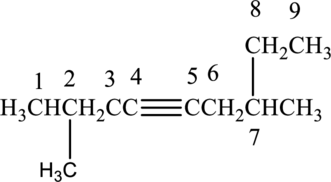
The substituent present in the given structure two methyl groups, each on carbon-2 and carbon-7. Number has to be added before the substituent names which indicate the carbon atom in which it is present. This gives the name of alkyne as 2,7-dimethyl-4-nonyne.

Longest carbon chain containing triple bond is nonane. Position of triple bond is 4-nonyne. Substituent present in the chain is 2,7-dimethyl. Correct IUPAC name of the structure given is 2,7-dimethyl-4-nonyne.
(d)
Interpretation:
Correct IUPAC name for the structure given has to be written.
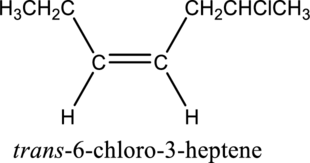
Concept Introduction:
Refer part (a).
(d)
Explanation of Solution
Given compound and IUPAC name is.
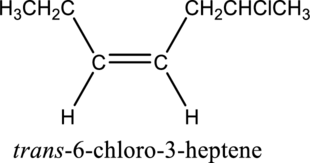
The configuration given in the IUPAC name is wrong as both hydrogen atoms are present on same side of the double bond. Correct IUPAC name can be given as shown below.
Numbering has to be given in a way that the double bond gets the least numbering. In this case, double bond is present between carbon-3 and carbon-4. Therefore, the parent alkyne is 3-heptene.
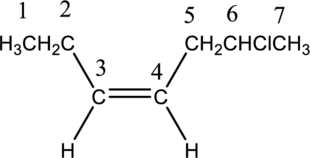
The substituent present in the given structure is a chloro group. Number has to be added before the substituent names which indicate the carbon atom in which it is present. This gives the name of alkene as 6-chloro-3-heptene. Looking into the stereo information, there are hydrogen atoms present on the same side of the double bond. Hence, the structure given is in cis conformation. Therefore, the name of the structure can be given as cis-6-chloro-3-heptene.
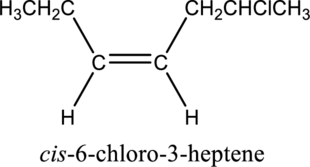
Longest carbon chain containing double bond is heptene. Position of double bond is 3-heptene. Substituent present in the chain is 6-chloro. Configuration is “cis”. Correct IUPAC name of the structure given is cis-6-chloro-3-heptene.
(e)
Interpretation:
Correct IUPAC name for the structure given has to be written.
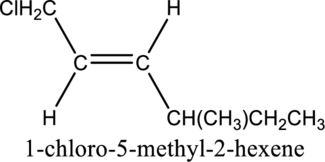
Concept Introduction:
Refer part (a).
(e)
Explanation of Solution
Given compound and IUPAC name is.
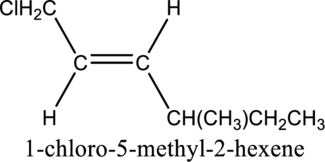
The configuration given in the IUPAC name is wrong as configuration is not given and the position of methyl substituent is wrong. Correct IUPAC name can be given as shown below.
Parent carbon chain is found to contain six carbon atoms. Therefore, the alkane is hexane.
Numbering has to be given in a way that the double bond gets the least numbering. In this case, double bond is present between carbon-2 and carbon-3. Therefore, the parent alkyne is 2-hexene.
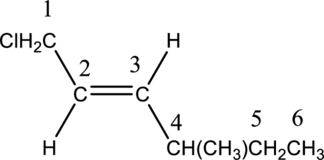
The substituent present in the given structure are a chloro group and a methyl group. Number has to be added before the substituent names which indicate the carbon atom in which it is present. This gives the name of alkene as 1-chloro-4-methyl. Looking into the stereo information, there are hydrogen atoms present on opposite side of the double bond. Hence, the structure given is in trans conformation. Therefore, the name of the structure can be given as trans-1-chloro-4-methyl2-hexene.
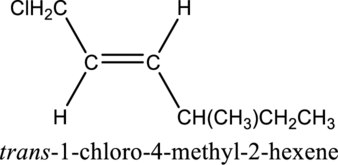
Longest carbon chain containing double bond is hexene. Position of double bond is 2-hexene. Substituent present in the chain is 1-chloro-4-methyl. Configuration is “trans”. Correct IUPAC name of the structure given is trans-1-chloro-4-methyl-2-hexene.
Want to see more full solutions like this?
Chapter 11 Solutions
General, Organic, and Biochemistry
- A concentration cell consists of two Sn/Sn2+ half-cells. The cell has a potential of 0.10 V at 25 °C. What is the ratio of [Sn2+] (i.e., [Sn2+left-half] / [Sn2+right-half])?arrow_forwardElectrochemical cell potentials can be used to determine equilibrium constants that would be otherwise difficult to determine because concentrations are small. What is Κ for the following balanced reaction if E˚ = +0.0218 V? 3 Zn(s) + 2 Cr3+(aq) → 3 Zn2+(aq) + Cr(s) E˚ = +0.0218 Varrow_forwardConsider the following half-reactions: Hg2+(aq) + 2e– → Hg(l) E°red = +0.854 V Cu2+(aq) + 2e– → Cu(s)E°red = +0.337 V Ni2+(aq) + 2e– → Ni(s) E°red = -0.250 V Fe2+(aq) + 2e– → Fe(s) E°red = -0.440 V Zn2+(aq) + 2e– → Zn(s) E°red = -0.763 V What is the best oxidizing agent shown above (i.e., the substance that is most likely to be reduced)?arrow_forward
- Calculate the equilibrium constant, K, for MnO2(s) + 4 H+(aq) + Zn(s) → Mn2+(aq) + 2 H2O(l) + Zn2+(aq)arrow_forwardIn the drawing area below, draw the condensed structures of formic acid and ethyl formate. You can draw the two molecules in any arrangement you like, so long as they don't touch. Click anywhere to draw the first atom of your structure. A C narrow_forwardWrite the complete common (not IUPAC) name of each molecule below. Note: if a molecule is one of a pair of enantiomers, be sure you start its name with D- or L- so we know which enantiomer it is. molecule Ο C=O common name (not the IUPAC name) H ☐ H3N CH₂OH 0- C=O H NH3 CH₂SH H3N ☐ ☐ X Garrow_forward
- (Part A) Provide structures of the FGI products and missing reagents (dashed box) 1 eq Na* H* H -H B1 B4 R1 H2 (gas) Lindlar's catalyst A1 Br2 MeOH H2 (gas) Lindlar's catalyst MeO. OMe C6H1402 B2 B3 A1 Product carbons' origins Draw a box around product C's that came from A1. Draw a dashed box around product C's that came from B1.arrow_forwardClassify each of the amino acids below. Note for advanced students: none of these amino acids are found in normal proteins. X CH2 H3N-CH-COOH3N-CH-COO- H3N-CH-COO CH2 CH3-C-CH3 CH2 NH3 N NH (Choose one) ▼ (Choose one) S CH2 OH (Choose one) ▼ + H3N-CH-COO¯ CH2 H3N CH COO H3N-CH-COO CH2 오오 CH CH3 CH2 + O C CH3 O= O_ (Choose one) (Choose one) ▼ (Choose one) Garrow_forwardAnother standard reference electrode is the standard calomel electrode: Hg2Cl2(s) (calomel) + 2e2 Hg() +2 Cl(aq) This electrode is usually constructed with saturated KCI to keep the Cl- concentration constant (similar to what we discussed with the Ag-AgCl electrode). Under these conditions the potential of this half-cell is 0.241 V. A measurement was taken by dipping a Cu wire and a saturated calomel electrode into a CuSO4 solution: saturated calomel electrode potentiometer copper wire CuSO4 a) Write the half reaction for the Cu electrode. b) Write the Nernst equation for the Cu electrode, which will include [Cu2+] c) If the voltage on the potentiometer reads 0.068 V, solve for [Cu²+].arrow_forward
- 2. (Part B). Identify a sequence of FGI that prepares the Synthesis Target 2,4-dimethoxy- pentane. All carbons in the Synthesis Target must start as carbons in either ethyne, propyne or methanol. Hint: use your analysis of Product carbons' origins (Part A) to identify possible structure(s) of a precursor that can be converted to the Synthesis Target using one FGI. All carbons in the Synthesis Target must start as carbons in one of the three compounds below. H = -H H = -Me ethyne propyne Synthesis Target 2,4-dimethoxypentane MeOH methanol OMe OMe MeO. OMe C₂H₁₂O₂ Product carbons' origins Draw a box around product C's that came from A1. Draw a dashed box around product C's that came from B1.arrow_forwardDraw the skeletal ("line") structure of the smallest organic molecule that produces potassium 3-hydroxypropanoate when reacted with KOH. Click and drag to start drawing a structure. Sarrow_forwardDraw the skeleatal strucarrow_forward
 ChemistryChemistryISBN:9781305957404Author:Steven S. Zumdahl, Susan A. Zumdahl, Donald J. DeCostePublisher:Cengage Learning
ChemistryChemistryISBN:9781305957404Author:Steven S. Zumdahl, Susan A. Zumdahl, Donald J. DeCostePublisher:Cengage Learning ChemistryChemistryISBN:9781259911156Author:Raymond Chang Dr., Jason Overby ProfessorPublisher:McGraw-Hill Education
ChemistryChemistryISBN:9781259911156Author:Raymond Chang Dr., Jason Overby ProfessorPublisher:McGraw-Hill Education Principles of Instrumental AnalysisChemistryISBN:9781305577213Author:Douglas A. Skoog, F. James Holler, Stanley R. CrouchPublisher:Cengage Learning
Principles of Instrumental AnalysisChemistryISBN:9781305577213Author:Douglas A. Skoog, F. James Holler, Stanley R. CrouchPublisher:Cengage Learning Organic ChemistryChemistryISBN:9780078021558Author:Janice Gorzynski Smith Dr.Publisher:McGraw-Hill Education
Organic ChemistryChemistryISBN:9780078021558Author:Janice Gorzynski Smith Dr.Publisher:McGraw-Hill Education Chemistry: Principles and ReactionsChemistryISBN:9781305079373Author:William L. Masterton, Cecile N. HurleyPublisher:Cengage Learning
Chemistry: Principles and ReactionsChemistryISBN:9781305079373Author:William L. Masterton, Cecile N. HurleyPublisher:Cengage Learning Elementary Principles of Chemical Processes, Bind...ChemistryISBN:9781118431221Author:Richard M. Felder, Ronald W. Rousseau, Lisa G. BullardPublisher:WILEY
Elementary Principles of Chemical Processes, Bind...ChemistryISBN:9781118431221Author:Richard M. Felder, Ronald W. Rousseau, Lisa G. BullardPublisher:WILEY





